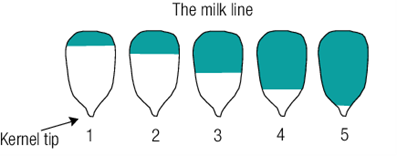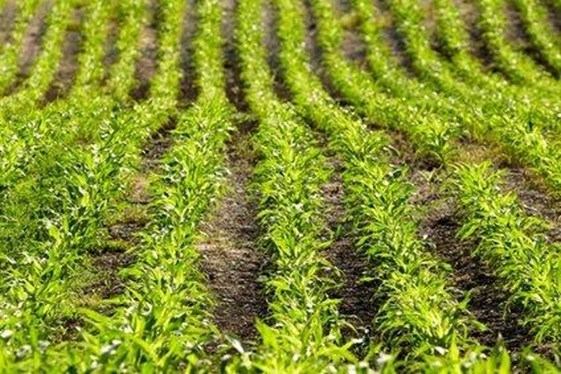The recent hot weather has meant that maize has accelerated and pushed through its final growth stages. Therefore, it is key to start assessing crops weekly from now on to make sure you harvest at the right time.
When assessing crops for their fitness for harvest, the quickest and easiest test to gauge the dry mater and maturity of the crop is the “milk-line” test. This test involves collecting a number of random cobs throughout the field, and assessing kernels to see where the milk-line meets the starch. This test helps to give an indicator of crop maturity and dry matter content. The diagram below explains how the milk line moves down through the crop as it becomes more mature:

When harvesting maize, target dry matters should be between 31-35%. To achieve this, the milk line needs to be 1/3 or ½ way down the kernel. Sometimes it can be difficult to see the milk line, therefore break the cob in half and then cut into the grain from the outer edge until you get milk. If you have used a stay green variety your milk line should be a little further on so that overall dry matter is within target levels.
Clamping Management
- Fill the clamp in thin layers, using a shallow wedge to ensure the whole clamp including the shoulders are well compacted.
- Fill the clamp in this “U” shape as you get better compaction and reduce the chance of damaging machinery by catching the RSJs.
- Making maize silage is a big investment so it is key to get your clamp management correct. Consolidate well by having an extra tractor rolling the clamp.
- Sheeting is important to reduce dry matter losses. Side sheets, cling film layer, plastic and heavy-duty cover will all improve the feeding out quality.
- Put weight on the sheet, sandbags around the sides and on top. Using bales on the ramp will significantly reduce wastage and spoilage on the ramp.
Additive?
As it stands now, there should be little need for any additive – the best additive in our view is diesel in the tank and extra rolling.
For any help in assessing crops or discussing forage requirements for the winter, then please don’t hesitate to get in touch!



